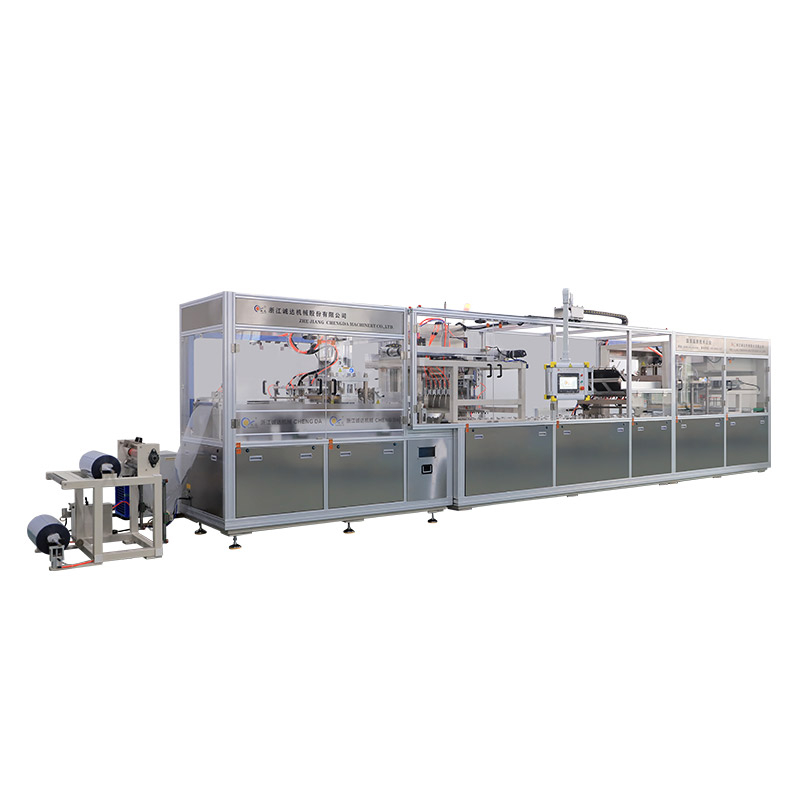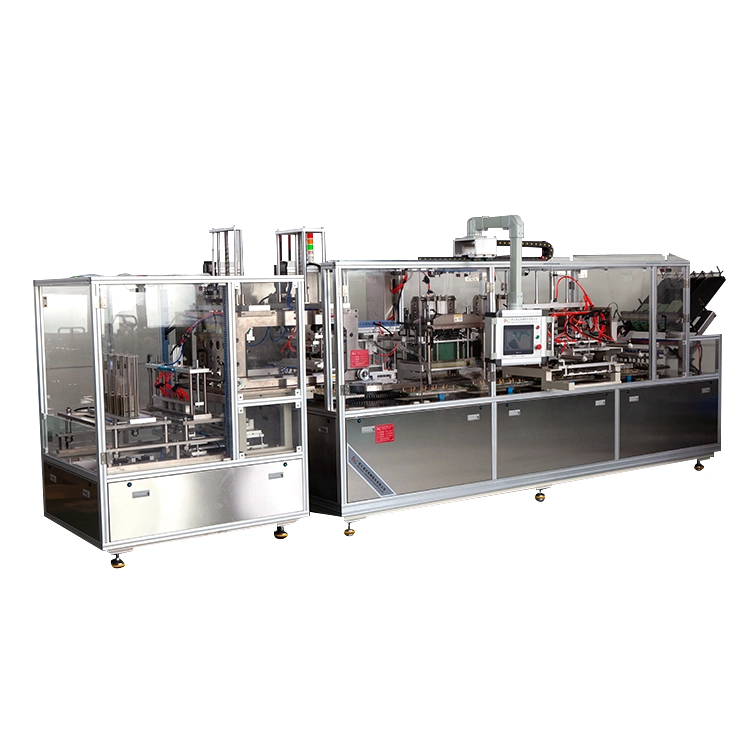Views: 0 Author: Site Editor Publish Time: 2025-09-21 Origin: Site






Are you choosing between automatic and semi-automatic blister packing machines? This decision can greatly impact efficiency and costs.
In this article, we’ll explore the pros and cons of each type. You'll learn how to select the right machine for your industry needs.
A blister packing machine is essential for packaging products securely. It forms a sealed cavity, often made of plastic, to hold items like pills or food. The purpose? To protect the contents from moisture, light, and contamination.
Blister packing machines are widely used across various industries. Here are some common applications:
● Pharmaceuticals: Protects medications and ensures dosage accuracy.
● Food: Keeps snacks fresh and extends shelf life.
● Medical Devices: Safeguards sensitive instruments and devices.
There are two main types of blister packing machines: automatic and semi-automatic.
These machines operate independently, with minimal human intervention. They are designed for high-volume production, making them ideal for large manufacturers. Key features include:
● Fast cycle times (up to 150 cycles per minute)
● Integrated quality control systems
● Reduced labor costs
Semi-automatic machines require some manual input. They are versatile and suitable for smaller production runs. Here’s what they offer:
● Lower initial costs (50-70% cheaper than automatic machines)
● Flexibility for custom orders
● Easier mold changes, typically within 10 minutes
Feature | Automatic Blister Packing Machines | Semi-Automatic Blister Packing Machines |
Speed | High (up to 150 cycles/min) | Moderate (600 units/hour) |
Labor Requirement | Minimal | Moderate (2-3 operators needed) |
Cost | Higher initial investment | More affordable |
Production Flexibility | Less adaptable for small batches | Highly adaptable for custom orders |
Maintenance Complexity | More complex | Simpler and easier to maintain |
Understanding these differences can help you choose the right blister packing machine for your needs. Each type has its unique advantages, depending on your production requirements.

Automatic blister packing machines are designed for high efficiency. They can achieve average cycle rates of up to 150 cycles per minute. This speed makes them perfect for high-volume production settings, where time is crucial.
● Ideal Applications: Industries such as pharmaceuticals and food benefit the most from this speed. They require fast and reliable packaging to meet consumer demand.
One of the biggest advantages of automatic machines is their reduced labor dependency. Automation significantly impacts labor costs.
● Labor Requirements: Automatic machines typically require fewer operators compared to semi-automatic machines. For instance, a semi-automatic machine may need two to three operators, while an automatic machine can often be run by one person.
Precision is key in packaging. Automatic blister packing machines excel in this area. They ensure uniform heat sealing, which is crucial for product integrity.
● Quality Control Features: Many automatic machines come equipped with integrated quality control features. These can include defect detection systems that help maintain high standards.
Automatic machines support a variety of materials. Common options include:
● PVC
● PVDC
● Eco-friendly alternatives
They can adapt to diverse products, including those with deep cavities of up to 12mm. This flexibility allows manufacturers to package various items effectively.
Scalability is another significant advantage. Automatic blister packing machines often feature modular designs.
● Benefits of Modular Designs: These allow for easy upgrades or expansions as production needs grow.
Additionally, they can integrate inline with other packaging systems, such as cartoners. This integration streamlines the entire packaging process, enhancing overall efficiency.
Advantage | Description |
High Efficiency | Up to 150 cycles/min, ideal for high volume |
Reduced Labor Dependency | Fewer operators needed, lowering labor costs |
Precision | Uniform heat sealing, integrated quality control |
Material Flexibility | Supports various materials, including eco-friendly |
Scalability | Modular designs for easy upgrades and integration |
These advantages make automatic blister packing machines an excellent choice for businesses looking to optimize their packaging operations.
One of the main drawbacks of automatic blister packing machines is their high initial cost. Typically, these machines start at around $50,000, but prices can vary based on features and capabilities.
● Financial Considerations: For small businesses, this cost can be a significant barrier. Investing in such machinery requires careful budgeting and planning.
Automatic machines often come with complex maintenance needs.
● Specialized Technicians: Repairs for servo motors or molds usually require specialized technicians, which can add to operational costs.
● Long-Term Costs: Over time, these maintenance requirements may lead to higher expenses compared to simpler machines.
Automatic blister packing machines are not always the best choice for small production runs.
● Mold Changeovers: Changing molds can take 30 to 60 minutes for automatic machines, while semi-automatic machines typically require only 10 to 15 minutes. This difference can slow down production for smaller batches.
● Production Suitability: They are ideal for large-scale production but may not be suitable for businesses that need flexibility for smaller orders.
Another consideration is the space requirements of automatic blister packing machines.
● Physical Footprint: These machines can be quite large, often measuring around 4.2 meters in length.
● Facility Layout: Businesses must carefully consider their facility layout to accommodate such machinery, which can limit options for smaller operations.
Disadvantage | Description |
High Initial Cost | Starting at $50,000, challenging for small businesses |
Complex Maintenance | Requires specialized technicians for repairs |
Limited Agility for Small Batches | Longer mold changeovers, less suited for small runs |
Space Requirements | Large physical footprint, affects facility layout |
These disadvantages highlight the challenges businesses face when considering automatic blister packing machines. While they offer many benefits, weighing these drawbacks is essential for making an informed decision.
One of the standout benefits of semi-automatic blister packing machines is their cost-effectiveness.
● Pricing Comparison: These machines are typically 50-70% cheaper than their automatic counterparts. This price difference makes them an attractive option for many businesses.
● Benefits for Startups: Startups and niche markets, such as artisanal food producers or medical prototype developers, find these machines particularly beneficial. They can invest in quality packaging without breaking the bank.
Semi-automatic machines offer remarkable flexibility and customization options.
● Quick Mold Changes: Changing molds takes about 10 minutes, allowing businesses to adapt quickly to different products or sizes.
● Support for Irregular Shapes: They can handle irregular shapes and hybrid materials, such as Tyvek-sealed medical blisters, making them versatile for various applications.
Another advantage is their user-friendly operation.
● Ease of Training: Training staff to operate these machines is straightforward. This ease of use means less downtime and quicker onboarding for new employees.
● Hands-On Quality Control: In critical applications, like HPAPI containment, hands-on quality control becomes essential. Semi-automatic machines allow operators to monitor the process closely, ensuring high standards are met.
Semi-automatic blister packing machines generally require lower maintenance.
● Mechanical Simplicity: Their simpler mechanical design means fewer parts that can break down, making repairs less frequent and easier to handle.
● Suitability for Limited Technical Support: In regions where technical support is limited, these machines are a practical choice. They don’t need specialized technicians for most repairs, which can save time and money.
Advantage | Description |
Cost-Effectiveness | 50-70% cheaper than automatic machines |
Flexibility and Customization | Quick mold changes, supports irregular shapes |
User-Friendly Operation | Easy to train staff, hands-on quality control |
Lower Maintenance Needs | Simpler mechanics, suitable for limited support |
These advantages make semi-automatic blister packing machines a smart choice for businesses looking to balance cost, flexibility, and operational efficiency.
One of the significant drawbacks of semi-automatic blister packing machines is their slower output rates.
● Output Comparison: While automatic machines can produce over 10,000 units per hour, semi-automatic models typically max out at around 600 units per hour.
● Implications for High-Demand Sectors: This slower speed can be a disadvantage for industries with high demand, such as pharmaceuticals or consumer goods, where rapid production is crucial.
Semi-automatic machines require more labor intensity.
● Number of Operators: Usually, 2 to 3 operators are needed for tasks like loading and sealing. This requirement increases operational costs and complicates staffing needs.
● Increased Error Risks: Manual processes can lead to higher error rates. Human mistakes during loading or sealing can compromise product quality and consistency.
Another concern is limited compliance with industry standards.
● GMP-Grade Enclosures: Semi-automatic machines may lack the necessary Good Manufacturing Practice (GMP)-grade enclosures. This can be a significant drawback in regulated industries.
● Additional Compliance Measures: Businesses might need to implement extra compliance measures, such as stainless-steel casings, to meet industry regulations, adding to costs and complexity.
Semi-automatic machines also face material limitations.
● Challenges with Thin Films: They can struggle with very thin films, like those under 0.15mm PVC, which require precise handling.
● Complex Seals: Tasks involving complex seals, such as ultrasonic welding, may be challenging for these machines. This limitation can restrict their use in certain applications.
Disadvantage | Description |
Slower Output Rates | Max output of 600 units/hour; less suitable for high demand |
Labor Intensity | Requires 2-3 operators; increased error risks |
Limited Compliance | Potential lack of GMP-grade enclosures; extra compliance needed |
Material Limitations | Challenges with thin films and complex seals |
These disadvantages highlight some of the challenges businesses may face when opting for semi-automatic blister packing machines. Understanding these limitations is essential for making informed decisions.

Automatic blister packing machines shine in scenarios where high-volume production is essential.
● Ideal Scenarios: If your business demands rapid output, these machines can handle large quantities efficiently, making them perfect for continuous production lines.
● Industries Benefiting Most: Industries like pharmaceuticals and food production gain significant advantages from automation. These sectors often require consistent quality and speed, which automatic machines provide.
On the other hand, semi-automatic blister packing machines are best suited for small batches and prototypes.
● Suitable Applications: They work well for businesses needing flexibility, such as those producing limited runs of products or testing new designs.
● Niche Markets: Specialized markets, like medical devices, benefit from the adaptability of these machines. They can easily accommodate unique shapes and materials that might not fit standard production lines.
A hybrid approach can be an effective strategy for many businesses.
● Advantages of Using Both Types: By integrating both automatic and semi-automatic machines, companies can optimize different production stages. For instance, they might use automatic machines for bulk production and semi-automatic ones for specialized runs.
● Cost-Saving Strategies: This combination can help startups save significantly, potentially reducing upfront costs by over $100,000. By carefully selecting the right machines for specific tasks, businesses can manage their budgets more effectively.
Recommendation | Description |
Choose Automatic Machines | Ideal for high-volume, consistent production |
Choose Semi-Automatic Machines | Best for small batches, prototypes, and flexibility |
Hybrid Approach | Combines strengths of both types; saves costs |
In summary, understanding when to use automatic versus semi-automatic blister packing machines can greatly enhance production efficiency and cost-effectiveness. Each type has unique strengths tailored to different needs and markets.
In this article, we explored the pros and cons of automatic and semi-automatic blister packing machines.
Automatic machines are ideal for high-volume production, especially in industries like pharmaceuticals and food.
Conversely, semi-automatic machines excel in small batches and niche markets.
When selecting a blister packing machine, consider your specific needs carefully.
Take the time to assess what works best for your production goals.
A: The typical lifespan ranges from 10 to 15 years, depending on usage and maintenance.
A: Assess your production volume, product type, and regulatory requirements to determine the best fit.
A: Maintenance costs vary; automatic machines generally require higher costs due to complex components.
A: Yes, upgrading is possible, but it may involve significant investment and adjustments.
A: Industries like pharmaceuticals, food, and cosmetics are leading adopters of blister packing machines.
